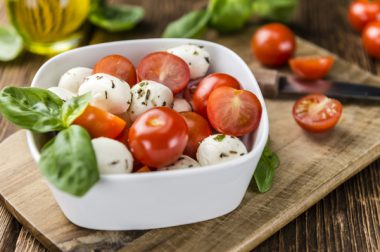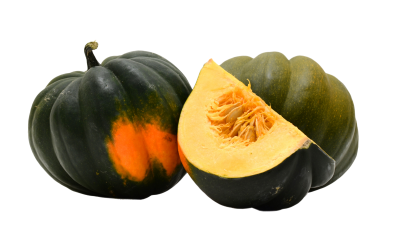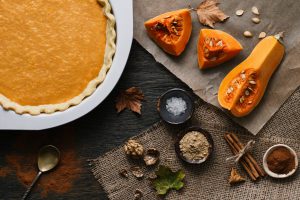Recipes we love
See all recipesRed kuri squash and shallots with honey
The sweet-and-savoury taste goes well with roasted poultry. The oil improves the assimilation of the...
Pumpkin gratin
Children like pumpkin because of its natural sweetness. Served as a gratin, it makes a good vegetabl...
Fried pumpkin
A nice way to discover a not so well-known vegetable. A dish with pro-vitamin A; a vitamin that help...
Health
benefits
A feast for the eye !
Squash contains a good amount of lutein and zeaxanthin, two antioxidants that help to protect the retina, a sensitive eyesight organ.
Squash is also :
- a source of provitamin A or beta-carotene (iron metabolism, skin and mucous membrane health, eyesight, immunity and growth) (link), which is indispensable for night vision.
It also contains :
- manganese
- potassium
- magnesium
- vitamin C
- vitamin B9
- vitamin B6
Nutritional
composition
When is the right
time to eat them?
All year.
But their high season runs from October to January, as squashes are mostly winter vegetables, with the notable exception of zucchini and pattypan squash, which are eaten in summer.
Vegetable patch or
urban balcony?
Squashes (Cucurbita pepo, maxima, melopepo, moschata) belong to the cucurbit family. They are sensitive to cold. Squash is sown at the end of spring, from the end of May till the beginning of June, when the frost period is over. Autumn frosts are also very harmful to the plant.
Squashes need lots of space in the vegetable patch: the bigger the fruit, the more ground space needs to be set aside for it. The recommended spacing between rows is about 2 to 2.5 m, and 0.5 to 0.6 m between seeds in a row. Moist soil is ideal for optimum growth of the plant and fruits. And in order for the fruit to grow, female flowers must be pollinated by male flowers. An average of one or two fruits per plant is obtained depending on the variety of squash. For miniature squashes like Baby Boo, Sweetie Pie, Jack-Be-Little and Munchkin, a single plant can produce 12 to 15 fruits.
To learn everything you need to know about growing squashes, read the page on growing advice.
Choosing and
storing squashes
Choose your squash well :
- Squashes should be smooth and very firm, and the skin should not have spots.
- Small squashes are better than large ones as their flesh is finer.
- The flesh should smell good and should not be slimy.
- Choose one that still has its stalk or stem: it will keep longer.
How to store your squash :
- In a cool, dry space: away from light for several months.
- In the refrigerator: cut, in plastic wrap, for three to four days.
- In the freezer: blanch the pieces before freezing.
Tips and
tricks
How to cook squash
Don’t peel squash, especially the summer varieties (zucchini and pattypan). The skin is tender after cooking. Cut it in two and remove the seeds. Summer squashes can be eaten raw or cooked. They can for instance be served in a salad, roasted in the oven, sautéed in a frying pan, and even baked.
Winter squashes are eaten cooked only.
Cooking time:
- 15 minutes: in a pressure cooker
- 40 minutes: in the oven
- 20 minutes: in boiling water
Squash goes well with…
Raw: Grated like carrots, or sliced in thin strips, squashes can make surprising and original starters. They go well with fresh herbs, lemon and fruit, and fresh cheese.
Cooked: Squashes are delicious in a soup, especially with carrots and ginger. They also go wonderfully in risottos, stews and curries. They are great either baked or pureed – try personalizing them with maple syrup, rosemary, walnuts, garlic, etc.
Spaghetti squash is excellent with tomato sauce: the effect is stunning!
Certain slightly sweet squashes (buttercup, red kuri or butternut) can be used to make delicious desserts (pies, cakes, muffins, etc.).
Anti-waste tip! Don’t throw away the seeds. First blanch, then roast them. Season and serve as an appetizer or on a salad.
Can everyone
eat them?

Young children
Children from the age of 12 months will enjoy them in a soup or puree or in desserts (cakes, sweets, pies, stewed, etc.).
And everyone else
Almost everyone likes their slightly sweet taste.
See plenty of other tips for encouraging children to eat vegetables.
Where do they come from?
Origins and varieties
Origins
People already consumed them in Mexico some 7,000 years BC, and squashes and zucchinis are a widespread tradition in the United States. Amerindians have for ages used a complementary, mixed farming technique called “three sisters”: corn, beans and squash are planted together so that each plant contributes to the growth and survival of the other two. Today, squashes are mainly grown in China, India, Russia, Iran, the United States, Egypt and Ukraine.
Varieties
Cylindrical, round, elongated, white, green, yellow, beige or orange, and whatever their size, squashes are astoundingly diverse.
Several varieties are known and grown:
- butternut and spaghetti squash (Cucurbita moschata)
- hubbard, red kuri and buttercup squash (Cucurbita maxima)
- zucchini, gem and pattypan squash are also members of this large family, but of a different species (Cucurbita pepo).
Among these varieties, two general categories are found: summer squash, and winter squash.
Summer squashes have thin skins; they are more fragile and cannot be kept as long. They are picked very young and unripe (green and yellow zucchini).
Winter squashes can be kept longer and their flesh is sweeter, dryer and orange-colored (pumpkin, red kuri).



 Artichoke
Artichoke  Borlotti beans
Borlotti beans  Vegetable garden: growing zucchini (courgette)
Vegetable garden: growing zucchini (courgette) 










